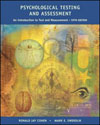Psychological Testing and Assessment: An Introduction To Tests and Measurement, 5/e
| Analogue study | Research or behavioral intervention that replicates a variable or variables in ways that are similar to or analogous to the real variables the experimenter wishes to study; for example, a laboratory study designed to research a phobia of snakes in the wild, 395
|
 |
 |
 |
| Apperceive | To perceive in terms of past perceptions (from this verb, the noun apperception is derived), 374
|
 |
 |
 |
| Behavioral assessment | An approach to evaluation based on the analysis of samples of behavior, including the antecedents and consequences of the behavior, 388-403
|
 |
 |
 |
| Contrast effect | A potential source of error in behavioral ratings when a dissimilarity in the observed behaviors or other things being rated leads to a more or less favorable rating than would have been made had the dissimilarity not existed, 401, 403
|
 |
 |
 |
| Free association | A technique, most frequently used in psychoanalysis, wherein the subject relates all his or her thoughts as they occur, 381n
|
 |
 |
 |
| Functional analysis | In behavioral assessment, the process of identifying the dependent and independent variables with respect to a presenting problem, 394-395
|
 |
 |
 |
| Inquiry | A typical element of Rorschach test administration; following the initial presentation of all ten cards, the assessor asks spe-cific questions designed, among other things, to determine what about each card led to the assessee's perceptions, 369
|
 |
 |
 |
| Objective personality test | Typically a test consisting of short-answer items where the assessee's task is to select one response from the two or more provided, and all scoring is done according to set procedures involving little if any judgment on the part of the scorer, 365-366
|
 |
 |
 |
| Penile plethysmograph | An instrument useful in the assessment and treatment of male sex offenders, designed to measure changes in penis volume as a function of sexual arousal, 399
|
 |
 |
 |
| Plethysmograph | An instrument that records changes in the volume of a part of the body arising from variations in blood supply, 399.
|
 |
 |
 |
| Polygraph | The instrument popularly known as a lie detector, 400, 516 Porteus Maze Test, 457
|
 |
 |
 |
| Projective hypothesis | The thesis that an individual supplies structure to unstructured stimuli in a manner consistent with the individual's own unique pattern of conscious and unconscious needs, fears, desires, impulses, conflicts, and ways of perceiving and responding, 367
|
 |
 |
 |
| Reactivity | Changes in an assessee's behavior, thinking, or performance that arise in response to being observed, assessed, or evaluated, 396
|
 |
 |
 |
| Role play | Acting an improvised or partially improvised part in a simulated situation, 398
|
 |
 |
 |
| Self-monitoring | The act of system-atically observing and recording aspects of one's own behavior and/or events related to that behavior, 396
|
 |
 |
 |
| Situational performance measure | A procedure that typically involves the performance of a task by the assessee under actual or simulated conditions while allowing for observation and evaluation by an assessor, 397-398
|
 |
 |
 |
| Testing the limits | (1) In ability testing, the continued administration of test items beyond the level at which the test manual dictates discontinuance; usually conducted only when the examiner has reason to believe an examinee can "pass" the higher-level items; (2) in the administration of the Rorschach test, an optional interview after the initial inquiry, in which the examiner asks questions designed to yield additional insights into the assessee's thought processes and personality, 263n, 369-370
|
 |
 |
 |
| Unobtrusive measure | A type of measure that does not necessarily require the presence or cooperation of respondents, often a telling physical trace or record, 400-401
|



 2002 McGraw-Hill Higher Education
2002 McGraw-Hill Higher Education